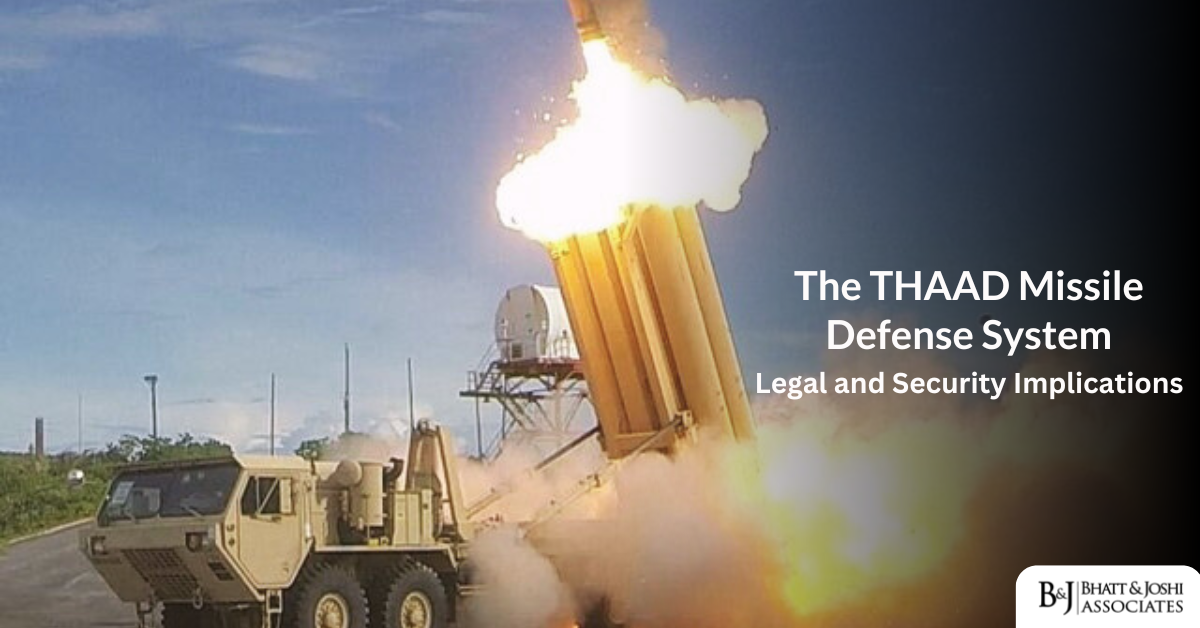Introduction
The Terminal High Altitude Area Defense (THAAD) missile defense system has become a pivotal element in modern military strategy. Designed to intercept and destroy short, medium, and intermediate-range ballistic missiles during their terminal phase, THAAD plays a critical role in global security dynamics. However, its deployment has raised significant legal and security questions that require careful examination. This article delves into the legal framework, regulatory mechanisms, and the broader implications of the THAAD system, considering relevant laws, treaties, and case laws.
Overview of the THAAD Missile Defense System
THAAD is a key component of the United States’ Ballistic Missile Defense System (BMDS). Manufactured by Lockheed Martin, it employs advanced radar and interception technology to neutralize missile threats at high altitudes. Unlike other missile defense systems, THAAD is designed to intercept threats both inside and outside the Earth’s atmosphere, offering unparalleled defense capabilities.
Initially conceived during the Strategic Defense Initiative in the 1980s, THAAD has evolved in response to emerging threats, particularly from rogue states and non-state actors. The system’s deployment in regions such as South Korea, the Middle East, and Europe has underscored its strategic importance but also ignited geopolitical tensions. Its effectiveness and technical sophistication make it a significant deterrent, yet it also places it at the heart of international legal and security debates.
Legal Framework Governing THAAD Missile Defense Systems
The development, deployment, and use of missile defense systems like THAAD are governed by an intricate web of international and domestic laws. At the international level, the most relevant legal instruments include the United Nations Charter, arms control treaties, and customary international law.
The United Nations Charter
The UN Charter’s principles of sovereignty, non-aggression, and collective security play a critical role in assessing the legality of deploying missile defense systems. Article 2(4) prohibits the use of force against the territorial integrity or political independence of any state, while Article 51 recognizes the inherent right of self-defense. THAAD’s deployment is often justified under Article 51, particularly when perceived threats emanate from states like North Korea and Iran. This right of self-defense must align with the principles of necessity and proportionality, which are central to customary international law.
In this context, the deployment of THAAD is often framed as a defensive measure rather than an act of aggression. However, the interpretation of these legal principles varies among states and has led to disputes about whether such systems exacerbate tensions rather than mitigate them. States opposing THAAD argue that its presence destabilizes regional security by provoking adversaries and undermining trust among neighboring nations.
Arms Control Treaties
Several treaties influence the legality of missile defense systems. The Anti-Ballistic Missile (ABM) Treaty, signed in 1972 between the United States and the Soviet Union, sought to limit the development of missile defense systems to preserve strategic stability. However, the United States’ withdrawal from the ABM Treaty in 2002 allowed the development of systems like THAAD to proceed unimpeded. Critics argue that this withdrawal undermined global arms control efforts and spurred an arms race by removing a key barrier to the proliferation of missile defense systems.
The collapse of the Intermediate-Range Nuclear Forces (INF) Treaty in 2019 further complicated the regulatory landscape. Although not directly regulating missile defense systems, the INF Treaty’s restrictions on intermediate-range missiles had significant implications for THAAD. The treaty’s dissolution allowed for the development and deployment of weapons that THAAD is designed to counter, creating a more volatile and unpredictable security environment.
Customary International Law
Customary international law, including principles of necessity and proportionality, also governs the deployment of missile defense systems. THAAD’s deployment in South Korea, for instance, has been justified as a proportional response to North Korea’s missile tests. However, its impact on regional stability and the principle of non-intervention has been a point of contention. The perception of THAAD as a unilateral imposition by the United States has fueled criticism, particularly from China and Russia, who view it as a violation of the spirit, if not the letter, of international law.
Security Implications of THAAD
The deployment of THAAD has profound security implications at regional and global levels. While it enhances defense capabilities, it also exacerbates geopolitical tensions and triggers arms races.
Regional Security Dynamics
In East Asia, the deployment of THAAD in South Korea has significantly altered the security landscape. While the system provides a shield against North Korean missile threats, it has also strained relations with China and Russia. Both countries perceive THAAD’s advanced radar capabilities as a threat to their security and have responded with military and economic countermeasures. For instance, China imposed economic sanctions on South Korea following the deployment of THAAD, underscoring the system’s destabilizing potential. The economic fallout included restrictions on South Korean businesses operating in China and a decline in Chinese tourism to South Korea, illustrating the multifaceted consequences of missile defense systems.
In the Middle East, THAAD’s deployment in countries like the United Arab Emirates serves as a deterrent against Iranian missile threats. However, it also risks escalating tensions in an already volatile region. Iran’s response to THAAD has included the development of more sophisticated missile systems, further fueling an arms race that destabilizes the broader Middle East.
Global Arms Race
The development and deployment of advanced missile defense systems like THAAD contribute to a global arms race. States perceive these systems as undermining the principle of mutually assured destruction (MAD), prompting them to develop more sophisticated offensive capabilities. Russia’s hypersonic missile programs and China’s advancements in missile technology are often seen as responses to the proliferation of missile defense systems. This dynamic creates a vicious cycle in which defensive measures provoke offensive advancements, perpetuating instability and undermining international peace and security.
Legal and Policy Challenges
The deployment of THAAD raises numerous legal and policy challenges, including questions of sovereignty, environmental impact, and the balance between national security and global stability.
Sovereignty and Consent
The principle of state sovereignty is a cornerstone of international law. The deployment of THAAD on foreign soil, such as in South Korea, requires the host nation’s consent. While South Korea’s government approved the system’s deployment, domestic opposition has highlighted the tensions between national security imperatives and public opinion. Protests against THAAD in South Korea have often centered on concerns about its implications for sovereignty, with critics arguing that its deployment serves U.S. strategic interests more than South Korean security needs.
Environmental Concerns
The environmental impact of THAAD installations has also been a contentious issue. In South Korea, environmental assessments were initially bypassed, leading to legal challenges and protests. The system’s radar emissions and construction footprint have raised concerns about potential health and ecological risks. These concerns have prompted courts to mandate comprehensive environmental assessments, illustrating the need to balance security imperatives with environmental stewardship.
Balancing National Security and Global Stability
While THAAD enhances the security of the deploying state and its allies, it also raises questions about the broader implications for global stability. Critics argue that missile defense systems undermine strategic stability by encouraging states to develop more advanced offensive capabilities. The resulting arms race increases the risk of miscalculation and conflict, highlighting the need for international mechanisms to manage the proliferation of missile defense technologies.
Case Laws and Judicial Interpretations
Legal challenges and judicial interpretations have played a critical role in shaping the discourse around THAAD. In South Korea, for instance, courts have addressed cases challenging the government’s decision to deploy THAAD without adequate environmental assessments. The South Korean Supreme Court ruled in favor of conducting comprehensive assessments, underscoring the importance of balancing security needs with environmental considerations.
In the United States, judicial scrutiny of missile defense programs has primarily focused on procurement and compliance with domestic laws. Cases such as McDonnell Douglas Corp. v. United States have highlighted the complexities of defense contracting and the need for transparency and accountability. These cases demonstrate the interconnectedness of legal, technical, and political considerations in the development and deployment of missile defense systems.
Key Judgments and Precedents
Several landmark judgments and precedents have shaped the legal landscape surrounding missile defense systems:
- The International Court of Justice (ICJ) Advisory Opinion on Nuclear Weapons (1996): Although not directly addressing missile defense, this opinion emphasized the principles of necessity and proportionality in the context of self-defense, which are relevant to systems like THAAD.
- South Korean Constitutional Court Decisions: The court’s rulings on THAAD-related cases have underscored the need for public participation and environmental safeguards in national security decisions. These rulings highlight the judiciary’s role in balancing competing interests and ensuring accountability.
- US Federal Court Rulings on Defense Procurement: Cases addressing transparency and compliance in defense contracts have influenced the development and deployment of systems like THAAD, emphasizing the need for oversight in defense spending.
Future Prospects and Recommendations
The legal and security challenges associated with THAAD underscore the need for robust regulatory frameworks and international cooperation. As missile threats evolve, so too must the laws and policies governing missile defense systems. Key recommendations include strengthening arms control treaties, enhancing transparency and accountability, promoting regional dialogues, and conducting comprehensive environmental assessments. Addressing these challenges will require a concerted effort by states, international organizations, and civil society to create a more stable and secure world.
Conclusion
The THAAD missile defense system represents a significant advancement in military technology, offering critical protection against evolving missile threats. However, its deployment raises complex legal and security questions that require careful consideration. By addressing these challenges through robust legal frameworks and international cooperation, states can harness the benefits of THAAD while minimizing its risks. As the global security environment continues to evolve, the interplay between technology, law, and policy will remain central to the discourse on missile defense systems.














